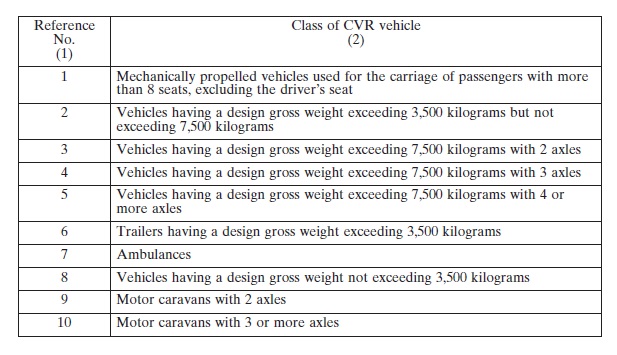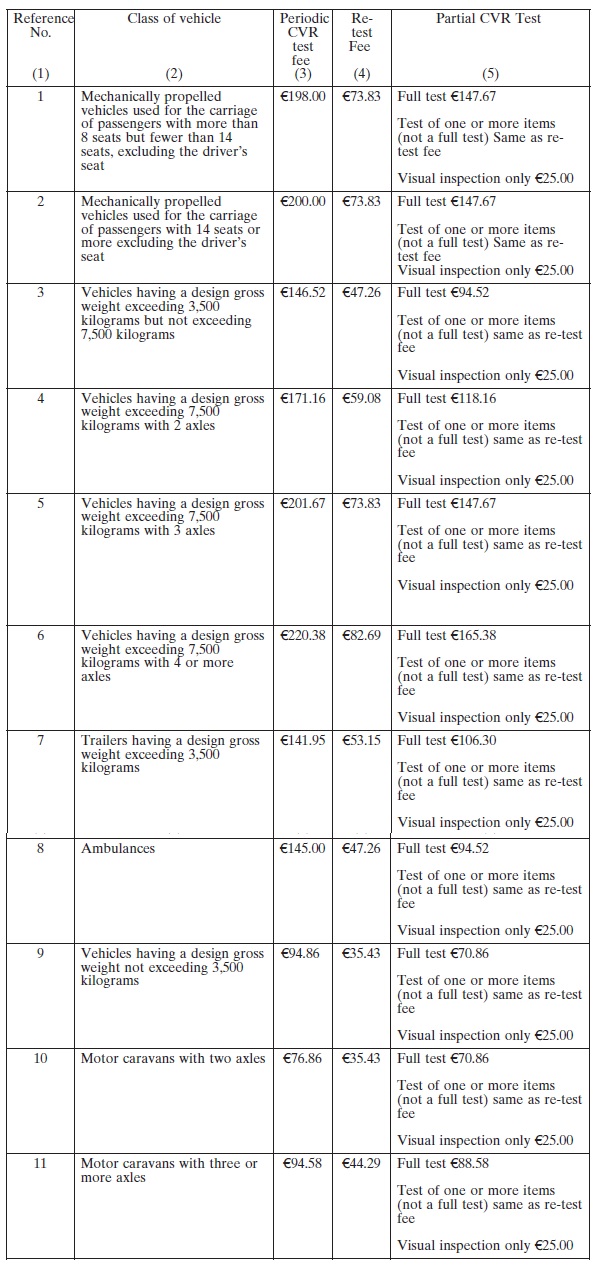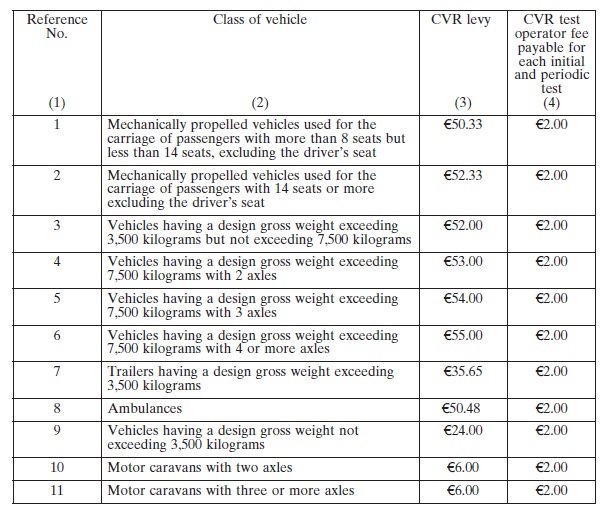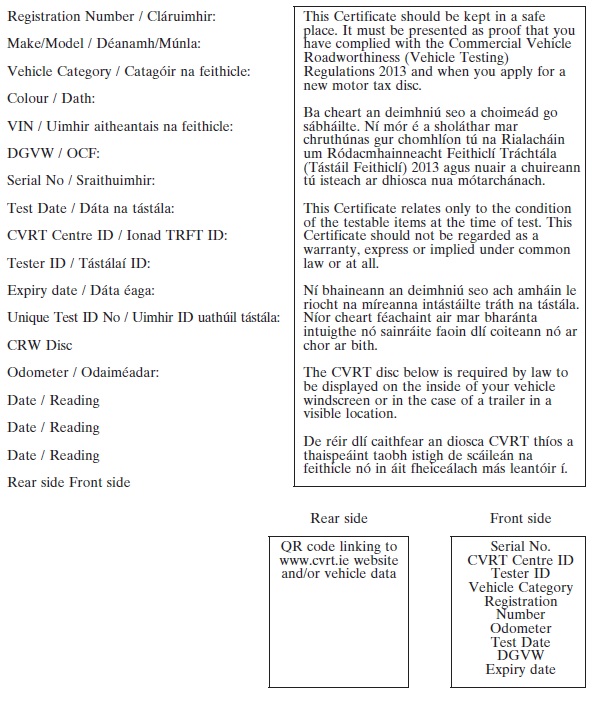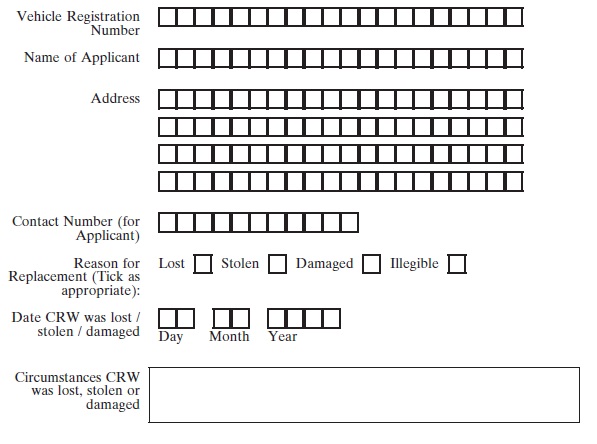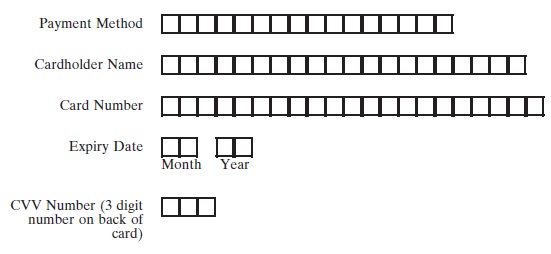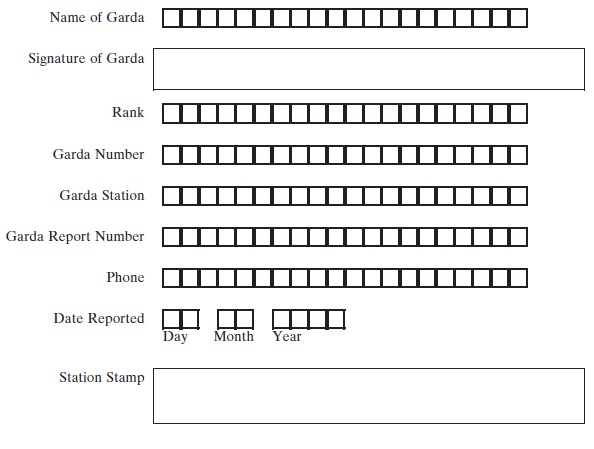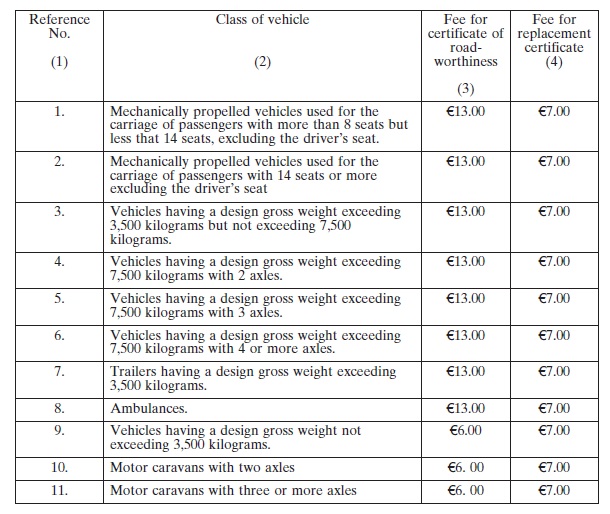S.I. No. 347/2013 - Commercial Vehicle Roadworthiness (Vehicle Testing) (No. 2) Regulations 2013.
Notice of the making of this Statutory Instrument was published in | ||
“Iris Oifigiúil” of 13th September, 2013. | ||
I, LEO VARADKAR, Minister for Transport, Tourism and Sport, in exercise of the powers conferred on me by sections 4 , 5 , 9 and 28 of the Road Safety Authority (Commercial Vehicle Roadworthiness) Act 2012 (No. 16 of 2012) and for the purpose of giving further effect to Directive 2009/40/EC of the European Parliament and of the Council of 6 May 20091 , as amended by Commission Directive 2010/48/EU of 5 July 20102 , hereby make the following regulations: | ||
Citation | ||
1. These Regulations may be cited as the Commercial Vehicle Roadworthiness (Vehicle Testing) (No. 2) Regulations 2013. | ||
Commencement | ||
2. These Regulations come into operation on 25th September 2013. | ||
Interpretation | ||
3. In these Regulations— | ||
“Act of 2012” means Road Safety Authority (Commercial Vehicle Roadworthiness) Act 2012 (No. 16 of 2012); | ||
“agricultural trailer” means a trailer, the property of a person engaged in agriculture, which is designed and used primarily for work on the land and which is used on a public road only incidentally to such work; | ||
“ambulance” means a mechanically propelled vehicle used for the purpose of carrying sick, injured or disabled persons; | ||
“articulated vehicle” means the combination of a mechanically propelled vehicle and a drawn vehicle attached by partial superimposition and so constructed and attached that not less than 20 per cent of the weight of the drawn vehicle is borne by the mechanically propelled vehicle; | ||
“authorisation plate” has the meaning assigned to it by Regulation 4 of the European Communities (Proof of Compliance) Regulations 2000 ( S.I. No. 223 of 2000 ); | ||
“Authority” means Road Safety Authority; | ||
“category”, in relation to a vehicle, means a category of vehicle within the meaning of Annex II to the Type-approval Framework Directive and references to particular categories of vehicle are to those categories of vehicle specified in that Annex; | ||
“CVR information system” means the computerised information system established by the Authority under section 28(1) of the Act of 2012; | ||
“CVR levy” and “CVR test operator fee” shall each be construed in accordance with Regulation 15; | ||
“date of first registration”, in relation to a vehicle, means— | ||
(a) the date on which the vehicle is entered in the register established and maintained by the Revenue Commissioners under section 131 of the Finance Act 1992 (No. 9 of 1992), or | ||
(b) where the vehicle is, or has been, registered in a jurisdiction other than the State— | ||
(i) the date on which the vehicle was first registered in accordance with the laws of that jurisdiction or, | ||
(ii) where only the year in which the vehicle was first registered in accordance with the laws of that jurisdiction is known, the day of the month on which the vehicle is entered in the register established and maintained by the Revenue Commissioners under section 131 of the Finance Act 1992 , in that year, | ||
whichever is earlier; | ||
“design gross vehicle weight” means the gross weight of a vehicle laden with the heaviest load that it can reasonably carry having regard to the engine capacity, brakes, tyres and general construction of such vehicle and shall, until the contrary is shown, be taken to be its design gross weight as specified by the manufacturer or, where the design gross weight of the vehicle as specified by the manufacturer is not ascertainable, the design gross weight of the vehicle as specified by an automotive engineer; | ||
“electronic record” means data that is recorded or stored on any medium using the CVR information system, a computer system, test equipment or other similar device and that can be read or perceived by a person, or accessed by a computer system or other similar device, and includes a display, print-out or other output of the data and any document, record, order, image, exhibit, notice or form that contains the data; | ||
“fax” means facsimile of a signed or written communication transmitted through the telecommunications system; | ||
“goods trailer” means a trailer, including a semi-trailer, constructed or adapted primarily for the conveyance of goods or burden of any description having a design gross weight exceeding 3,500 kilograms but excluding an agricultural trailer; | ||
“goods vehicle” means a mechanically propelled vehicle, or an articulated vehicle, constructed or adapted primarily for the conveyance of goods or burden of any description whether or not the vehicle is used for such a purpose including a living van; | ||
“issuing authority” means an issuing authority within the meaning of the Regulations of 2013; | ||
“livestock” means cattle, sheep, swine, horses and all other bovine and equine animals, poultry, goats and deer, not in the wild state; | ||
“living van” means a vehicle, whether mechanically propelled or not, which may also be used as living accommodation by one or more persons and which is, or may be, also used for the carriage of goods or burden (including livestock and more than one motor cycle) which are not needed by such one or more persons for the purpose of their residence in the vehicle; | ||
“mechanically propelled vehicle” has the same meaning as it has in the Road Traffic Act 1961 (No. 24 of 1961); | ||
“motor caravan” has the meaning assigned to it in Annex II of the Type-approval Framework Directive; | ||
“partial CVR test” means a roadworthiness test of a CVR vehicle on foot of a direction issued under— | ||
(a) section 31 or 35 of the Act of 2012 by an authorised officer, or | ||
(b) section 35 of the Act of 2012 by a CVR inspector; | ||
“pass statement” shall be construed in accordance with Regulation 23; | ||
“periodic CVR test” means a test carried out on a vehicle in accordance with Regulation 16 other than a re-test, a partial CVR test or a recall test; | ||
“recall test” shall be construed in accordance with Regulation 31; | ||
“Regulations of 2004” means European Communities (Vehicle Testing) Regulations 2004 ( S.I. No. 771 of 2004 ); | ||
“Regulations of 2013” means the Road Safety Authority (Vehicle Testing) Regulations 2013 ( S.I. No. 106 of 2013 ); | ||
“re-test” means a test carried out on a vehicle in accordance with Regulation 16 on foot of the refusal of a pass statement in respect of that vehicle, where— | ||
(a) the re-test is carried out on a day which is not more than 21 days after the day on which the pass statement was refused, and | ||
(b) the reading on the vehicle’s odometer at presentation for the re-test is no more than 4,000 kilometres greater than the reading at the time the pass statement was refused; | ||
“Roadworthiness Directive” means Directive 2009/40/EC of the European Parliament and of the Council of 6 May 20091, as amended by Commission Directive 2010/48/EU of 5 July 20102; | ||
“semi-trailer” means the drawn component of an articulated vehicle, or a vehicle constructed or adapted for use as such drawn component; | ||
“special purpose vehicle” means a special purpose vehicle within the meaning of Annex II to the Type-approval Framework Directive and references to special purpose vehicles in a particular category are to special purpose vehicles in that category within the meaning of that Annex; | ||
“test due date” shall be construed in accordance with Regulations 5 to 9; | ||
“test report” shall be construed in accordance with Regulation 22; | ||
“testing date” shall be construed in accordance with Regulations 8 and 9; | ||
“trailer” means a vehicle attached to a mechanically propelled vehicle (or to another vehicle attached to a mechanically propelled vehicle) or a vehicle constructed or adapted for the purpose of being drawn by a mechanically propelled vehicle; | ||
“transitional period” means the period beginning on the date that these Regulations come into operation and ending on 6th October 2013; | ||
“Type-approval Framework Directive” means Directive 2007/46/EC of the European Parliament and of the Council of 5 September 20073 , as last amended by Commission Regulation (EU) No. 195/2013 of 7 March 20134 ; | ||
“VIN” means the unique alphanumeric code assigned to a vehicle by the manufacturer in order to ensure proper identification of the vehicle. | ||
Application — CVR vehicles | ||
4. (1) Subject to paragraphs (2) and (3) these Regulations apply to the following vehicles: | ||
(a) vehicles with more than 8 seats, excluding the driver’s seat, used for the carriage of passengers (categories M2 and M3); | ||
(b) goods vehicles (categories N1, N2 and N3); | ||
(c) goods trailers (categories O3 and O4); | ||
(d) ambulances (special purpose vehicles in category M); | ||
(e) motor caravans first registered on or after 1 January 1980 (special purpose vehicles in category M). | ||
(2) These Regulations do not apply to vehicles which are used by the Defence Forces or the Garda Síochána. | ||
(3) Regulation 5 does not apply to vehicles that are not registered in the State. | ||
Frequency of testing | ||
5. A vehicle shall be submitted for testing in respect of each test due date. | ||
Test due dates | ||
6. (1) Subject to Regulations 7, 8 and 9 the following shall be test due dates in respect of a CVR vehicle: | ||
(a) the first test due date; | ||
(b) in the case of a class of CVR vehicle of a class specified in column (2) of Schedule 1 at reference numbers 1 to 8 in column (1), each subsequent anniversary of the first test due date; | ||
(c) in the case of a CVR vehicle of a class specified in column (2) of Schedule 1 at reference numbers 9 and 10 in column (1)— | ||
(i) before the tenth anniversary of its date of first registration, each subsequent second anniversary of the first test due date, and | ||
(ii) after the tenth anniversary of its date of first registration, each subsequent anniversary of that date. | ||
(2) Subject to paragraph (3), the first test due date for a CVR vehicle is the first anniversary of its date of first registration. | ||
(3) The first test due date for a class of CVR vehicle specified in column (2) of Schedule 1 at reference numbers 9 and 10 in column (1) is the fourth anniversary of its date of first registration. | ||
Test due dates — certificate of roadworthiness in force | ||
7. Notwithstanding Regulation 6, where on the commencement of these Regulations there is in force in respect of a CVR vehicle a certificate of roadworthiness issued under the Regulations of 2004 or the Regulations of 2013 the test due dates in respect of that vehicle shall be— | ||
(a) the expiry date of such certificate of roadworthiness, | ||
(b) in the case of a class of CVR vehicle of a class specified in column (2) of Schedule 1 at reference numbers 1 to 8 in column (1), each subsequent anniversary of that expiry date; | ||
(c) in the case of a CVR vehicle of a class specified in column (2) of Schedule 1 at reference numbers 9 and 10 in column (1)— | ||
(i) before the tenth anniversary of its date of first registration, each subsequent second anniversary of that expiry date, and | ||
(ii) after the tenth anniversary of its date of first registration, each subsequent anniversary of that expiry date. | ||
Test due dates — early testing | ||
8. Where a CVR vehicle is submitted for CVR testing on a date (“testing date”) falling more than one month before a test due date, the following shall be the test due dates for that vehicle: | ||
(a) in the case of a CVR vehicle of a class specified in column (2) of Schedule 1 at reference numbers 1 to 8 in column (1), each subsequent anniversary of the testing date; | ||
(b) in the case of a CVR vehicle of a class specified in column (2) of Schedule 1 at reference numbers 9 and 10 in column (1)— | ||
(i) before the tenth anniversary of its first date of registration, each subsequent second anniversary of the testing date, or | ||
(ii) after the tenth anniversary of its first date of registration, each subsequent anniversary of the testing date. | ||
Test due dates — late testing | ||
9. (1) Where a CVR vehicle is submitted for CVR testing on a testing date more than one year after a test due date the next test due date in respect of that vehicle (in addition to the test due dates specified in Regulation 6, 7 or 8 as the case may be) shall be— | ||
(a) the date falling 6 months after the testing date, or | ||
(b) the next test due date under Regulation 6, | ||
whichever is earlier. | ||
CVR tests | ||
10. The following tests are prescribed for the purposes of these Regulations: | ||
(a) a periodic CVR test; | ||
(b) a re-test; | ||
(c) a partial CVR test; | ||
(d) a recall test. | ||
Application for CVR test | ||
11. (1) An application for a CVR test shall be made by, or on behalf of, the owner of the CVR vehicle to be tested to a CVR test operator either in person, by post, by fax, by telephone, by email or by using the CVR information system. | ||
(2) An application under paragraph (1) shall include the following: | ||
(a) the preferred CVR test centre for the carrying out of the test; | ||
(b) the preferred date and time for the carrying out of the test; | ||
(c) the registration or trailer licensing number of the vehicle to be tested; | ||
(d) the VIN, chassis number or date of first registration of the vehicle to be tested; | ||
(e) the type and category of the vehicle to be tested; | ||
(f) the type of test to be carried out. | ||
Use of CVR information system | ||
12. (1) Where an application for a periodic CVR test is made other than by using the CVR information system, the CVR test operator, or a person acting on his or her behalf, shall record details of the application on the CVR information system prior to the CVR test being carried out. | ||
(2) Prior to a partial CVR test being carried out at a CVR test centre, the CVR test operator, or a person acting on his or her behalf, shall record on the CVR information system the following: | ||
(a) the registration number of the CVR vehicle; | ||
(b) the type and class of CVR vehicle to be tested; | ||
(c) the name of the person presenting the CVR vehicle for a partial CVR test; | ||
(d) the items to be tested. | ||
CVR test fees — transitional period | ||
13. The fees to be paid for CVR tests carried out during the transitional period are those fees specified in Regulation 12 of the Regulations of 2013. | ||
CVR test fees | ||
14. (1) After the end of the transitional period the fee to be paid for a periodic CVR test carried out in respect of a class of vehicle specified in column (2) of Schedule 2 at any reference number in column (1) is the amount specified in column (3) of that Schedule opposite mention of that reference number. | ||
(2) Subject to paragraph (3), the fee to be paid for a re-test carried out after the end of the transitional period in respect of a class of vehicle specified in column (2) of Schedule 2 at any reference number in column (1) is the amount specified in column (4) of that Schedule opposite mention of that reference number. | ||
(3) No fee shall be paid for a re-test that does not require the use of test equipment. | ||
(4) The fee to be paid for a partial CVR test carried out after the end of the transitional period in respect of a class of vehicle specified in column (2) of Schedule 2 at any reference number in column (1) is the amount specified in column (5) of that Schedule opposite mention of that reference number. | ||
(5) The amounts specified in Schedule 2 are exclusive of any value-added tax which may be applicable. | ||
(6) Where a CVR test is carried out otherwise than in accordance with these Regulations the CVR test operator shall refund any fee paid in respect of the test. | ||
CVR test levy and CVR test operator fee | ||
15. (1) After the end of the transitional period the fixed amount of a CVR fee to be paid to the Authority by a CVR test operator (“CVR levy”) prior to carrying out a periodic CVR test in respect of a class of vehicle specified in column (2) of Schedule 3 at any reference number in column (1) is the amount specified in column (3) of that Schedule opposite mention of that reference number. | ||
(2) After the end of the transitional period the fee to be paid to the Authority by a CVR test operator (“CVR test operator fee”) prior to carrying out a periodic CVR test in respect of a class of vehicle specified in column (2) of Schedule 3 at any reference number in column (1) is the amount specified in column (4) of that Schedule opposite mention of that reference number. | ||
(3) The amounts specified in Schedule 3 are exclusive of any value-added tax which may be applicable. | ||
Items to be tested | ||
16. (1) The items to be inspected and tested in the course of a periodic CVR test are— | ||
(a) the items specified in Annex II to the Roadworthiness Directive, and | ||
(b) in the case of vehicle categories M2, M3, N2, N3, O3 and O4, the authorisation plate in respect of vehicle weights and dimensions, the fitment of which is required by the Road Traffic (Construction, Equipment and Use of Vehicles) (Amendment) Regulations 2000 ( S.I. No. 224 of 2000 ). | ||
(2) Subject to paragraphs (3) and (4), the items to be inspected and tested in the course of a re-test are those items which gave rise to the refusal of a pass statement. | ||
(3) Where a CVR vehicle is presented for a re-test at a CVR test centre other than the CVR test centre at which the pass statement was refused the items to be inspected and tested in the re-test shall be those specified in subparagraphs (a) and (b) of paragraph (1). | ||
(4) Where a CVR tester forms the opinion during a re-test on a CVR vehicle that an item other than an item that gave rise to the refusal of the pass statement may render that vehicle unroadworthy or defective, the CVR tester shall— | ||
(a) notify the owner of the CVR vehicle, or a person acting on behalf of such owner, of his or her opinion, and | ||
(b) test that vehicle in accordance with paragraph (1). | ||
(5) Where an item tested under paragraph (4)(b) is found to render a vehicle unroadworthy, the CVR tester shall not issue a pass statement in respect of that vehicle. | ||
(6) The items to be inspected and tested in the course of a partial CVR test on foot of a direction are those specified in the direction. | ||
(7) The items to be inspected and tested in the course of a recall test required on foot of a notice under Regulation 31 are those specified in the notice. | ||
CVR testing method | ||
17. The testing methods to be employed during a CVR test are those specified in— | ||
(a) Annex II to the Roadworthiness Directive, and | ||
(b) any guidelines issued by the Authority. | ||
Test equipment | ||
18. The Authority shall specify in guidelines the equipment to be used for the purposes of carrying out CVR tests. | ||
Prohibition on CVR tester carrying out CVR tests | ||
19. A CVR tester shall not carry out a CVR test on a CVR vehicle where— | ||
(a) the CVR tester, or the CVR test operator authorised in respect of the CVR testing centre at which the test is to be carried out, is not authorised to carry out CVR tests on vehicles of the type, or in the category, to which the CVR vehicle belongs, | ||
(b) the CVR tester is suspended from carrying out CVR tests, | ||
(c) the CVR tester does not have the use of one or more of the items of test equipment necessary to carry out the test as specified by the Authority in guidelines, | ||
(d) the test equipment necessary to carry out the test is not calibrated or is faulty, | ||
(e) the CVR tester is physically unfit to conduct the test or is under the influence of alcohol or drugs, or a combination of both. | ||
Refusal to test | ||
20. (1) A CVR tester may refuse to carry out a CVR test on a vehicle— | ||
(a) if in his or her opinion— | ||
(i) any part of the CVR vehicle or any of its equipment is in such a condition that it would not be safe to carry out the test, | ||
(ii) a load on the CVR vehicle is not adequately secured or is in such condition that it would not be safe to carry out the test, | ||
(iii) the CVR vehicle has been presented in such a condition that he or she cannot access a part or parts of the vehicle to carry out the test, or | ||
(b) if the fee for the test has not been paid. | ||
(2) Where a CVR tester refuses to carry out a CVR test on a vehicle in accordance with paragraph (1) the test operator to whom the application for the test was made shall— | ||
(a) immediately provide details of the CVR vehicle to the Authority using such means of communication as may be specified by the Authority in guidelines, and | ||
(b) return to the owner of the vehicle, or the person acting on his or her behalf, any fee paid under Regulation 13 or 14 in respect of the test. | ||
Test information | ||
21. (1) A CVR test operator shall notify the Authority of the following information in respect of each test carried out, or caused to be carried out, by him or her: | ||
(a) the type of test; | ||
(b) the registration or trailer licensing number of the vehicle tested; | ||
(c) the VIN or chassis number of the vehicle; | ||
(d) the type and category of the vehicle; | ||
(e) the name of the person who presented the vehicle for testing and details of the identification furnished by the person at that time; | ||
(f) the time at which the test started and finished; | ||
(g) the reading on the odometer at the time of the test (expressed in either miles or kilometres) as confirmed with the person who presented the vehicle; | ||
(h) the outcome of the tests (including the results of each test); | ||
(i) the identity of the CVR tester who carried out the test; | ||
(j) details of the test equipment used during the test; | ||
(k) electronic records, measurements, images or data generated by the test equipment during the test; | ||
(l) records relating to visual inspections; | ||
(m) any declarations or observations recorded by a CVR test operator or CVR tester relating to a CVR test; | ||
(n) financial records relating to fees payable under these Regulations or under the Act of 2012; | ||
(o) such other information relating to CVR testing as the Authority may reasonably request. | ||
(2) The information specified in paragraph (1) shall be notified to the Authority— | ||
(a) using the CVR information system, on the same day as the CVR test is carried out, or | ||
(b) in such other manner, and within such timeframe, as may be specified by the Authority in guidelines. | ||
Test report | ||
22. (1) On the completion of a CVR test of a vehicle, the CVR test operator shall give to the owner, or the person acting on behalf of the owner, a report of the test (“test report”) which shall specify any item found during the test to render the vehicle unroadworthy. | ||
(2) Where a CVR test of a vehicle is not completed by the CVR tester, the test report shall contain the words “Not Complete”. | ||
(3) Where a test report containing the words “Not Complete” is given to an owner, or a person acting on his or her behalf, and the CVR vehicle to which the test report relates is subsequently presented for testing it shall be tested in accordance with Regulation 16(1). | ||
Pass Statement | ||
23. (1) Subject to Regulation 24, where a CVR test operator is satisfied that a CVR vehicle is roadworthy in respect of the items specified for the class of vehicle concerned in Regulation 16(1), such CVR test operator shall issue a statement (“pass statement”) in the form approved by the Authority to the owner of the CVR vehicle, or a person acting on his or her behalf. | ||
(2) A pass statement issued in respect of a vehicle under these Regulations shall not be valid unless issued by the CVR tester who tested the vehicle. | ||
(3) A pass statement given or continued under the Regulations of 2013 which is valid immediately before the commencement of these Regulations shall remain valid in accordance with its terms. | ||
(4) A CVR vehicle for which a pass statement was refused under the Regulations of 2013 may be submitted for a re-test under these Regulations. | ||
Refusal of pass statement | ||
24. A CVR test operator shall not issue a pass statement in respect of a CVR vehicle where— | ||
(a) the vehicle has not been tested in accordance with these Regulations, | ||
(b) the test report specifies one or more items found during testing to render the vehicle unroadworthy, | ||
(c) all relevant sections of the test report and pass statement have not been duly completed, | ||
(d) the VIN for the vehicle presented to the CVR tester is not identical to the number recorded on the entry relating to the vehicle on the CVR information system, | ||
(e) the CVR vehicle has been modified for a purpose other than that recorded on the entry relating to the vehicle on the CVR information system, | ||
(f) the CVR vehicle has been modified in a manner that the CVR tester reasonably believes may affect the roadworthiness of the vehicle and neither the owner of the CVR vehicle, nor a person acting on his or her behalf, produces, not later than 21 days after the date on which the vehicle was tested, a report of such modifications in such form as may be specified by the Authority in guidelines, | ||
(g) the person who presents the vehicle for testing, following a request by a CVR tester to remove an item not relevant to the CVR test from the CVR vehicle or to secure an item in such manner as the CVR tester may specify, fails or refuses to so remove or secure the item, or | ||
(h) the person who presents the vehicle for testing fails to produce either his or her driving licence or passport, or such other photographic identification as the Authority may specify in guidelines, within a period of 21 days after the date on which the vehicle was tested. | ||
Certificate of roadworthiness — issue | ||
25. (1) Where a pass statement is issued by a CVR test operator in accordance with Regulation 23 the Authority shall— | ||
(a) issue a certificate of roadworthiness to the owner of the vehicle in the form specified in Schedule 4, | ||
(b) where the person who presents the vehicle to be tested notifies the CVR test operator that the name of the owner of the vehicle entered in the licensing records specified in the Road Vehicles (Registration and Licensing) (Amendment) Regulations 1992 ( S.I. No. 385 of 1992 ) is to be amended, allow a period of 14 days to elapse for such amendment to be made and then issue a certificate of roadworthiness to the owner of the vehicle in the form specified in Schedule 4, or | ||
(c) direct the owner of the vehicle to make an application under paragraph (2). | ||
(2) An application for a certificate of roadworthiness in respect of a vehicle may be made to an issuing authority in accordance with the Regulations of 2013 where— | ||
(a) the pass statement in respect of the vehicle was given or continued under the Regulations of 2013, | ||
(b) the application is made during the transitional period, or | ||
(c) the application is made on foot of a direction under paragraph (1)(c). | ||
(3) Where a pass statement issued in accordance with Regulation 23 is valid in respect of a vehicle, an issuing authority shall issue a certificate of roadworthiness to the owner of the vehicle in accordance with Regulation 8 of the Regulations of 2013 and it shall be valid under these Regulations in accordance with its terms. | ||
(4) Proof issued in a Member State (other than the State) showing that a motor vehicle registered on the territory of that Member State, together, where applicable, with its trailer or semitrailer, has passed a roadworthiness test complying with at least the provisions of the Roadworthiness Directive shall be a certificate of roadworthiness for the purposes of the Act of 2012. | ||
Certificate of roadworthiness issued under previous Regulations | ||
26. A certificate of roadworthiness issued under the Regulations of 2004 or the Regulations of 2013 which is in force immediately before the commencement of these Regulations continues in force until the date specified on the said certificate to be the date of its expiry. | ||
Certificate of roadworthiness — validity and display | ||
27. (1) Subject to Regulation 30, a certificate of roadworthiness issued under these Regulations in respect of a vehicle is valid from its issue date until the earlier of— | ||
(a) the vehicle’s next test due date, or | ||
(b) the date on which a new pass statement is issued in respect of the vehicle. | ||
(2) The owner and the driver of a CVR vehicle shall ensure that the disc attached to a certificate of roadworthiness issued under these Regulations in respect of that vehicle is displayed— | ||
(a) in the case of a CVR vehicle fitted with a front windscreen, on the front windscreen where it can be easily inspected but causes minimum obstruction of the driver’s view, and | ||
(b) in the case of any other CVR vehicle, on the near side of the vehicle where it is clearly visible and can be easily inspected. | ||
(3) A person shall not alter with intent to defraud or deceive, or to display knowing it to be so altered, any certificate of roadworthiness (including, in the case of a certificate of roadworthiness issued under these Regulations, the attached disc). | ||
(4) A person shall not display or allow to be displayed a certificate of roadworthiness (including, in the case of a certificate of roadworthiness issued under these Regulations, the attached disc) which he or she knows, or ought reasonably to know, is not valid. | ||
(5) A person shall not knowingly display a certificate of roadworthiness (including, in the case of a certificate of roadworthiness issued under these Regulations, the attached disc) on a vehicle other than the vehicle to which the certificate of roadworthiness relates. | ||
(6) Where a certificate of roadworthiness (including, in the case of a certificate of roadworthiness issued under these Regulations, the attached disc) is damaged or becomes illegible the owner of the vehicle to which the certificate of roadworthiness relates, or a person acting on his or her behalf, shall apply for a replacement certificate of roadworthiness. | ||
Replacement certificate of roadworthiness | ||
28. (1) Subject to paragraph (3), the Authority may issue a replacement certificate of roadworthiness where an original certificate of roadworthiness is lost or stolen or becomes damaged or illegible. | ||
(2) An application for a replacement certificate of roadworthiness shall be made to the Authority by the owner of the vehicle in respect of which the original certificate was issued in writing or through the CVR information system and shall— | ||
(a) contain information relating to the circumstances giving rise to the application, | ||
(b) where the original certificate has not been lost or stolen, be accompanied by the original certificate, | ||
(c) be accompanied by a duly completed declaration in the form specified in Schedule 5, and | ||
(d) be accompanied by the appropriate fee. | ||
(3) Where a certificate of roadworthiness that was lost or stolen, and in respect of which a replacement has been issued in accordance with paragraph (2), is found or recovered the owner of the CVR vehicle to which it relates shall immediately give it up to the Authority. | ||
Certificate of roadworthiness — fees | ||
29. (1) The fee to be paid to an issuing authority with an application for a certificate of roadworthiness under Regulation 25(2) in respect of a class of CVR vehicle specified in Column (2) of Schedule 6 at any reference number in column (1) is the amount specified in column (3) of that Schedule opposite mention of that reference number. | ||
(2) The fee to be paid to the Authority with an application for a replacement certificate of roadworthiness issued under Regulation 28 in respect of a class of CVR vehicle specified in Column (2) of Schedule 6 at any reference number in column (1) is the amount specified in column (4) of that Schedule opposite mention of that reference number. | ||
Revocation of certificate of roadworthiness | ||
30. The Authority may revoke a certificate of roadworthiness where— | ||
(a) it is reported lost or stolen, | ||
(b) the Authority has reasonable grounds for believing that the pass statement to which the vehicle relates— | ||
(i) was not issued in accordance with the Act of 2012, Regulations made thereunder, or any guidelines, or | ||
(ii) was issued in contravention of a direction given by an authorised officer or CVR inspector, | ||
or | ||
(c) the CVR vehicle to which it relates fails a recall test under Regulation 31. | ||
(2) Where the Authority revokes a certificate of roadworthiness in accordance with paragraph (1), the pass statement issued in respect of the vehicle to which the certificate of roadworthiness relates is also revoked. | ||
(3) An authorised officer or a CVR inspector may require, either in person or by notice in writing, the owner of a CVR vehicle to give up to the Authority a certificate of roadworthiness or pass statement revoked under this Regulation. | ||
(4) The owner of a CVR vehicle who is required to give up a certificate of roadworthiness or pass statement under paragraph (3) shall ensure that the certificate or statement, as the case may be, is given up to the Authority in accordance with such requirement. | ||
Recall of CVR vehicle | ||
31. (1) Where, following the issue of a pass statement or a certificate of roadworthiness in respect of a CVR vehicle— | ||
(a) an authorised officer, having exercised a power under section 25 or 31 of the Act of 2012, or | ||
(b) a CVR inspector, having exercised a power under section 34 of the Act of 2012, | ||
forms the opinion that the CVR test was not carried out in accordance with the Act of 2012, these Regulations or any guidelines, the authorised officer or CVR inspector, as the case may be, may, by notice in writing addressed to the owner of the CVR vehicle and to the CVR test operator who issued the pass statement, require such owner to present the vehicle for CVR testing under the supervision of an authorised officer or a CVR inspector (“recall test”). | ||
(2) A notice under paragraph (1) shall specify— | ||
(a) the CVR vehicle recalled to be tested, | ||
(b) the reason for the recall test, | ||
(c) the CVR testing centre at which the recall test is to be carried out, and | ||
(d) the time and date by which the CVR vehicle shall be presented for the recall test. | ||
(3) The owner of a CVR vehicle to whom a notice is given under paragraph (1) shall ensure that the CVR vehicle specified in the notice is presented for CVR testing not later than the time and date specified in such notice. | ||
(4) Any costs or fees arising from the recall test of a vehicle required under paragraph (1) shall be borne by the CVR test operator who issued the pass statement in relation to the vehicle re-tested unless the Authority directs otherwise. | ||
Recovery of costs of repeated inspections | ||
32. (1) Where on foot of repeated non-compliance by a CVR test operator with his or her authorisation or Part 1 of the Act of 2012 (including any regulations made under that Part or any directions or guidelines) repeated inspections are carried out by an authorised officer under section 25 of the Act of 2012 for the purposes of verifying compliance, the CVR test operator shall pay to the Authority for each repeated inspection the applicable fee specified in Schedule 7. | ||
(2) A fee payable under this Regulation shall be recoverable as a simple contract debt in any court of competent jurisdiction. | ||
Recovery of costs of reconnecting to CVR Information system | ||
33. The fee for reconnecting the CVR information system following the termination, or expiry, of a suspension of an authorisation as a CVR test operator is that specified in Schedule 8 and shall be paid to the Authority. | ||
Penal provisions | ||
34. (1) The following are penal provisions for the purposes of section 5 of the Act of 2012: | ||
(a) Regulation 27 (other than paragraphs (1) and (6)); | ||
(b) Regulation 30(4); | ||
(c) Regulation 31(3). | ||
(2) Where a person is charged with an offence under section 5 of the Act of 2012, consisting of a contravention of Regulation 27(2), 30(4) or 31(3), it is a defence to the charge if the person shows that he or she exercised due diligence and took all reasonable steps to avoid contravening the provision. | ||
Revocations | ||
35. The following provisions of the Commercial Vehicle Roadworthiness (Vehicle Testing) Regulations 2013 ( S.I. No. 106 of 2013 ) are revoked: | ||
(a) Regulations 3 to 7; and | ||
(b) Regulation 11. | ||
Regulation 6, 7, and 8 | ||
Schedule 1 | ||
CVR Vehicles | ||
| ||
Regulation 14 | ||
Schedule 2 | ||
CVR test fees | ||
| ||
Regulation 15 | ||
Schedule 3 | ||
CVR test levy and operator fees | ||
| ||
Regulation 25 | ||
Schedule 4 | ||
Certificate of Roadworthiness / Deimhniú Ródachainneachta | ||
It is hereby certified that the vehicle described in this Certificate was tested on the date below in accordance with the Road Safety Authority (Commercial Vehicle Roadworthiness) Act, 2012 and any regulations made thereunder and was found to comply therewith. | ||
Deimhnítear leis seo gur dearnadh an fheithicil atá tuairiscithe sa Deimhniú seo a thástáil ar an dáta thíos de réir an Achta fán Údarás um Shábháilteacht ar Bhóithre (Ródacmhainneacht Feithiclí Tráchtála) 2012 agus Rialachán um Thástáil Feithiclí ar bith a rinneadh faoin gcéanna agus gur cinneadh gur chomhlíon sí iad. | ||
| ||
Regulation 28 | ||
Schedule 5 | ||
Certificate of Roadworthiness (CRW) Replacement | ||
Before your application can be processed you are required to complete the form on the following pages, and post it to the RSA. | ||
Please Note: The replacement Certificate of Roadworthiness will be sent to the address of the Registered Owner of the Vehicle according to National Vehicle Driver File at the time your application is being processed. You will find the registered owner details on your vehicle registration certificate. If these details are incorrect, please contact your local Motor Tax Office to get the details amended. | ||
What you need to do | ||
Please tick to confirm your application is complete | ||
□ Sections 1 & 2 have been completed in full | ||
□ Section 3 has been signed and dated | ||
□ You have taken the form to your local Garda station and they have completed, signed and stamped the Garda Section 4 | ||
□ You have checked that the registered owner details, as displayed on your vehicle registration certificate, are correct | ||
□ You have attached the original damaged or illegible CRW including the disc (mandatory when applying for a replacement for this reason) | ||
Where to send your application | ||
Send the completed application form or submit it in person to: | ||
CRW Replacements, Road Safety Authority, Clonfert House, Bride Street, Loughrea, Co. Galway | ||
Section 1 — Applicant Details | ||
| ||
Section 2 — Payment details | ||
Please debit my VISA/Mastercard/American Express/Laser/Debit Card with the amount of €7.00 | ||
| ||
Section 3 — Declaration | ||
I hereby apply for a replacement Certificate of Roadworthiness (CRW) and I attach the original illegible certificate and disc or undertake to immediately return the lost or stolen original to the Road Safety Authority if it should subsequently be found or recovered. I am aware the Certificate of Roadworthiness will be sent to the registered owner of the vehicle. I hereby apply for a replacement Certificate of Roadworthiness (CRW) and I attach the original illegible certificate and disc or undertake to immediately return the lost or stolen original to the Road Safety Authority if it should subsequently be found or recovered. I am aware the Certificate of Roadworthiness will be sent to the registered owner of the vehicle. | ||
| ||
Section 4 — Garda Report | ||
The person named above reported the above Certificate of Roadworthiness lost, stolen, damaged or illegible. I am satisfied on the basis of the information available to the Gardai at this station and the position as elaborated on by the applicant, that this appears to be a valid application. The applicant has been reminded that any person making a false declaration is liable to prosecution and on conviction to heavy penalties. | ||
| ||
Regulation 29 | ||
Schedule 6 | ||
Certificate of roadworthiness fees | ||
| ||
Regulation 32 | ||
Schedule 7 | ||
Reimbursement of costs of repeat inspections | ||
| ||
Regulation 33 | ||
Schedule 8 | ||
Reimbursement of cost of reconnection to CVR information system | ||
| ||
| ||
GIVEN under my Official Seal, | ||
10 September 2013. | ||
LEO VARADKAR T.D., | ||
Minister for Transport, Tourism and Sport. | ||
EXPLANATORY NOTE | ||
(This note is not part of the Instrument and does not purport to be a legal interpretation) | ||
These Regulations specify the requirements and arrangements to apply for the compulsory testing of light commercial vehicles and heavy commercial vehicles in accordance with the Road Safety Authority (Commercial Vehicle Roadworthiness Act 2012 (No. 16 of 2012)). | ||
The Regulations provide for the following:- | ||
(a) the category of commercial vehicles to be tested and the timing and frequency of tests; | ||
(b) options for making an application for a test and the information to be furnished when making an application for a test; | ||
(c) items to be tested or re-tested and conditions in respect of the conduct of tests including a requirement for the person presenting the vehicle for a test or re-test to provide specified identification; | ||
(d) the issuance of test reports, pass statements and certificates of roadworthiness and revocation of a pass statement and certificate of roadworthiness in particular circumstances; | ||
(e) fees payable for tests, re-tests and certificates of roadworthiness and collection of a levy in respect of initial and periodic tests; | ||
(f) fees payable for repeated inspections by authorised officers necessary to verify compliance by a testing centre; | ||
(g) requirements relating to the use of and operation of the Commercial Vehicle Roadworthiness Information System (CoVIS) in connection with testing. | ||
(h) the format of a certificate of roadworthiness. | ||
The Regulations also revoke the following provisions of the Commercial Vehicle Roadworthiness (Vehicle Testing) Regulations 2013 ( S.I. No. 106 of 2013 ): | ||
(a) Regulations 3 to 7 | ||
(b) Regulation 11. | ||
1 OJ No. L 141, 6.6.2009, p. 12 2 OJ No. L 173, 8.7.2010, p. 47 |

